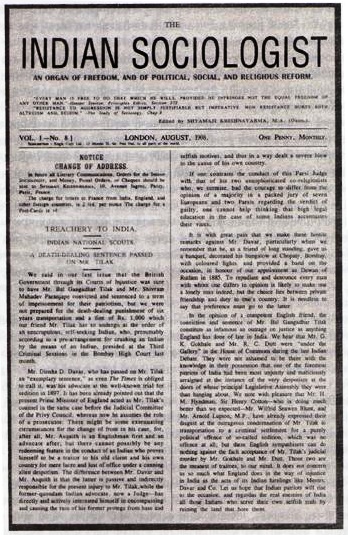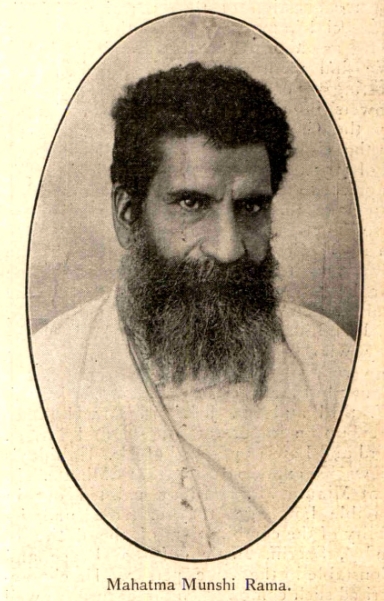|
Dayananda Saraswati
Dayanand Saraswati () (born Mool Shankar Tiwari; 2 February 1824 – 30 October 1883) also known as Maharshi Dayanand is an Indian philosopher, social leader and founder of the Arya Samaj, a Hindu reform movement. His Magnum Opus is the book Satyarth Prakash which has remained a highly influential text on the Philosophy of the Vedas and clarifications of various ideas and duties of Human Beings. He was the first to give the call for '' Swaraj'' as "India for Indians" in 1876, a call later taken up by Lokmanya Tilak.Aurobindo Ghosh, ''Bankim Tilak Dayanand'' (Calcutta 1947, p. 1) "Lokmanya Tilak also said that Swami Dayanand was the first who proclaimed Swaraj for Bharatpita i.e. India." Denouncing the idolatry and ritualistic worship, he worked towards reviving Vedic ideologies. Subsequently, the philosopher and President of India, S. Radhakrishnan called him one of the "makers of Modern India", as did Sri Aurobindo. He considered the infallible authority of the Ve ... [...More Info...] [...Related Items...] OR: [Wikipedia] [Google] [Baidu] |
Arya Samaj
Arya Samaj ( hi, आर्य समाज, lit=Noble Society, ) is a monotheistic Indian Hindu reform movement that promotes values and practices based on the belief in the infallible authority of the Vedas. The samaj was founded by the sannyasi (ascetic) Dayanand Saraswati on 7 April 1875. Arya Samaj was the first Hindu organization to introduce proselytization in Hinduism. The organization has also worked towards the growth of civil rights movement in India since 1800s. Dayananda Saraswati and Foundation The Arya Samaj was established in Bombay on 10 April 1875 by Dayananda Saraswati (born ''Mool Shankar Tiwari)''.E News Aryasamaj website 2 March 2010. Retrieved 3 February 2017 An alternative date for the foundation of the samaj is 24 June 1877 because it was then, in |
Yāska
Yāska was an ancient Indian grammarian and linguist disputed.html" ;"title="st. 7th–5th century BCE(disputed">st. 7th–5th century BCE(disputed) Preceding Pāṇini [est. 7th–4th century BCE(Controversy, disputed)], he is traditionally identified as the author of '' Nirukta,'' the discipline of "etymology" (explanation of words) within Sanskrit grammatical tradition and the '' Nighantu'', the oldest proto-thesaurus in India. Yaska is widely regarded as the precursive founder of the discipline of what would become etymology in both the East and the West. "यास्काचार्यो यस्कस्य अपत्यं स्यात्" The name Yaaska is probably a patronymic name meaning of Yaska यस्क. It is uncertain however who Yaska यस्क could have been."अपि पाणिनीयदृश्यते" The patronymic of Yaska is also seen in Panini's great work: The Astadhyayi (See Kashika commentary on Sutra फक्फिञ ... [...More Info...] [...Related Items...] OR: [Wikipedia] [Google] [Baidu] |
Ram Prasad Bismil
Ram Prasad Bismil ( Hindi: राम प्रसाद "बिस्मिल") (11 June 1897 — 19 December 1927) was an Indian poet, writer, revolutionary and an Indian freedom fighter who participated in the Mainpuri Conspiracy of 1918, and the Kakori Conspiracy of 1925, and fought against British Raj. He also had a good command over Urdu and the Hindi languages and was an accomplished poet, composing in these languages using the pen names Ram, Agyat and Bismil, the latter through which he became famously known by. He was also a multilingual translator and his Hindi poem "Manipuri ki Pratigya" became very famous. Bismil was hanged on 19 December 1927 by the British for his revolutionary activities. He was associated with Arya Samaj where he got inspiration from '' Satyarth Prakash'', a book written by Swami Dayanand Saraswati. He also had a confidential connection with Lala Har Dayal through his guru Swami Somdev, a preacher of Arya Samaj. Bismil was one of the foundin ... [...More Info...] [...Related Items...] OR: [Wikipedia] [Google] [Baidu] |
Madan Lal Dhingra
Madan Lal Dhingra (18 September 1883 — 17 August 1909) was an Indian revolutionary, pro-independence activist. While studying in England, he assassinated William Hutt Curzon Wyllie, a British official. Early life Madan Lal Dhingra was born on 18 September 1883 in Amritsar, India, in an educated and affluent Hindu Punjabi Khatri family. His father, Dr. Ditta Mal Dhingra, was a civil surgeon, and Madan Lal was one of eight children (seven sons and one daughter). All seven sons, including Dhingra, studied abroad. Dhingra studied at Amritsar in MB Intermediate College until 1900. He then went to Lahore to study at the Government College University. Here, he was influenced by the incipient nationalist movement, which at that time was about seeking Home Rule rather than independence. Dhingra was especially troubled by the poverty of India. He studied the literature concerning the causes of Indian poverty and famines extensively, and felt that the key issues in seeking sol ... [...More Info...] [...Related Items...] OR: [Wikipedia] [Google] [Baidu] |
Lala Hardayal
Lala Har Dayal Mathur ( Punjabi: ਲਾਲਾ ਹਰਦਿਆਲ; 14 October 1884 – 4 March 1939) was an Indian nationalist revolutionary and freedom fighter. He was a polymath who turned down a career in the Indian Civil Service. His simple living and intellectual acumen inspired many expatriate Indians living in Canada and the U.S. in their campaign against British rule in India during the First World War. Biography Har Dayal Mathur was born in a Hindu Mathur Kayastha family on 14 October 1884 at Delhi. He studied at the Cambridge Mission School and received his bachelor's degree in Sanskrit from St. Stephen's College, Delhi and his master's degree also in Sanskrit from Punjab University. In 1905, he received two scholarships of Oxford University for his higher studies in Sanskrit: Boden Scholarship, 1907 and Casberd Exhibitioner, an award from St John's College, where he was studying. He moved to the United States in 1911, where he became involved in industrial un ... [...More Info...] [...Related Items...] OR: [Wikipedia] [Google] [Baidu] |
Vinayak Damodar Savarkar
Vinayak Damodar Savarkar (), Marathi pronunciation: �inaːjək saːʋəɾkəɾ also commonly known as Veer Savarkar (28 May 1883 – 26 February 1966), was an Indian politician, activist, and writer. Savarkar developed the Hindu nationalist political ideology of Hindutva while imprisoned at Ratnagiri in 1922. He was a leading figure in the Hindu Mahasabha. He started using the honorific prefix ''Veer'' meaning "brave" since he wrote his autobiography. Savarkar joined the Hindu Mahasabha and popularized the term ''Hindutva'' (Hinduness), previously coined by Chandranath Basu, to create a collective "Hindu" identity as an essence of Bharat (India). Savarkar was an atheist but a pragmatic practitioner of Hindu philosophy. Savarkar began his political activities as a high school student and continued to do so at Fergusson College in Pune. He and his brother founded a secret society called Abhinav Bharat Society. When he went to the United Kingdom for his law studies, h ... [...More Info...] [...Related Items...] OR: [Wikipedia] [Google] [Baidu] |
Shyamji Krishna Varma
Shyamji Krishna Varma (4 October 1857 – 30 March 1930) was an Indian revolutionary fighter, an Indian patriot, lawyer and journalist who founded the Indian Home Rule Society, India House and '' The Indian Sociologist'' in London. A graduate of Balliol College, Krishna Varma was a noted scholar in Sanskrit and other Indian languages. He pursued a brief legal career in India and served as the ''Divan'' of a number of Indian princely states in India. He had, however, differences with Crown authority, was dismissed following a supposed conspiracy of British colonial officials at Junagadh and chose to return to England. An admirer of Dayanand Saraswati's approach of cultural nationalism, and of Herbert Spencer, Krishna Varma believed in Spencer's dictum: "Resistance to aggression is not simply justified, but imperative". In 1905, he founded the India House and '' The Indian Sociologist'', which rapidly developed as an organised meeting point for radical nationalists among Indi ... [...More Info...] [...Related Items...] OR: [Wikipedia] [Google] [Baidu] |
Swami Shraddhanand
Swami Shraddhanand (22 February 1856 – 23 December 1926), also known as Mahatma Munshi Ram Vij, was an Arya Samaj sannyasi and an Indian Independence activist who propagated the teachings of Dayananda Saraswati. This included the establishment of educational institutions, like the Gurukul Kangri University, and played a key role on the ''Sangathan'' (consolidation and organization) and the '' Shuddhi'' (purification), a Hindu reform movement in the 1920s. Early life and education He was born on 22 February 1856 in the village of Talwan in the Jalandhar District of the Punjab Province of India. He was the youngest child in the family of Lala Nanak Chand, who was a Police Inspector in the United Provinces (now Uttar Pradesh), then administered by the East India Company. His given name was Brihaspati Vij, but later he was called Munshi Ram Vij by his father, a name that stayed with him till he took sanyas in 1917, variously as Lala Munshi Ram Vij and Mahatma Munshi Ram. He adop ... [...More Info...] [...Related Items...] OR: [Wikipedia] [Google] [Baidu] |
Pandit Lekh Ram
Pandit Lekh Ram (1858 – 6 March 1897) was the leader of the Arya Samaj, an Indian Hindu reform movement, and was also active as a writer and publicist. He is known particularly for his encounters with Mirza Ghulam Ahmad, the founder of the Ahmadiyya movement, and as a subject of his death prophecy. His assassination by an unidentified assailant on March 6, 1897 is believed by Ahmadi Muslims to have occurred in accordance with Ahmad's prophecy concerning him. Early life Pandit Lekh Ram was born in April 1858 in a small village of ''Sayyedpur'', Jhelum District. His father's name was Tara Singh and his mother was Bhag Bhari. He served in the Punjab Police for some years, and when posted at Peshawar, he came under the influence of the teachings of Munshi Kanhaiya Lal Alakhdhari and learned of the Arya Samaj movement and its founder Dayanand Saraswati. He resigned the Police service voluntarily and devoted his life for the propagation of Vedas and became a preacher of ''Punjab Ar ... [...More Info...] [...Related Items...] OR: [Wikipedia] [Google] [Baidu] |
Madam Cama
Bhikaiji Rustom CamaBhi''ai''- (with aspirated ''-kh-'') is the name as it appears in the biographies. Another common form is Bhi''ai''- (with unaspirated ''-k-''), as it appears on the postage stamp. The name is also frequently misspelled 'Bhikh''''-' (with missing ''-i-''), which is a male name (unlike the feminine Bhikh''''-). (24 September 1861 – 13 August 1936) or simply as, Madam Cama, was one of the prominent figures in the Indian independence movement. Bhikaiji Cama was born in Bombay (now Mumbai) in a large, affluent Parsi Zoroastrian family. Her parents, Sorabji Framji Patel and Jaijibai Sorabji Patel, were well known in the city, where her father Sorabji—a lawyer by training and a merchant by profession—was an influential member of the Parsi community. She unfurled the first version of flag of independent India on August 21, 1907, when an International Socialist Conference was being held at Stuttgart, a city in Germany. Like many Parsi girls of the time ... [...More Info...] [...Related Items...] OR: [Wikipedia] [Google] [Baidu] |
Kapila
Kapila ( sa, कपिल), also referred to as Cakradhanus, is a sage in Hindu tradition. According to Bhagavata Purana, he is the son of the sage Kardama and Devahuti, the daughter of the Svayambhuva Manu. Kardama had nine daughters, who were very learned and went ahead to marry Marici, as well as other great sages. When he came of age, Kapila is most well-known as the founder of the Samkhya school of Hindu philosophy., Quote:"Kapila (fl. 550 BC), Vedic sage and founder of the system of Samkhya, one of the six schools of Vedic philosophy." Kapila of Samkhya fame is considered a Vedic sage, estimated to have lived in the 6th-century BCE, or the 7th-century BCE. His home was in Mithila. His influence by Buddha and Buddhism have long been the subject of scholarly studies. According to the Brahmanda Purana, Kapila is described to be an incarnation of Vishnu: "Bhagavān Nārāyaṇa will protect us all. The Lord of the universe has now been born in the world as Kapilācārya ... [...More Info...] [...Related Items...] OR: [Wikipedia] [Google] [Baidu] |




.jpg)
